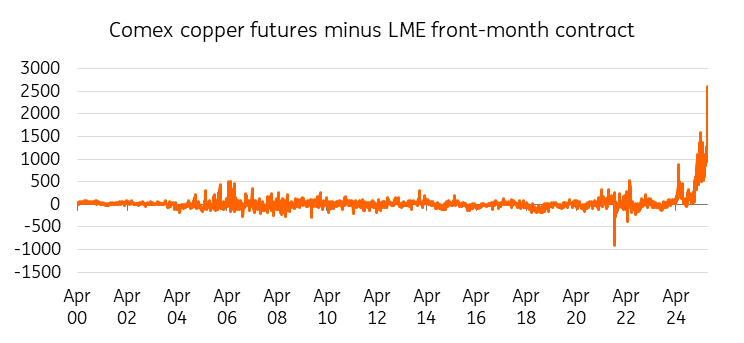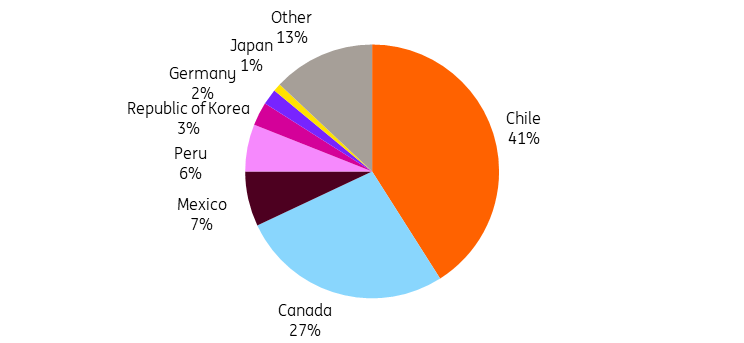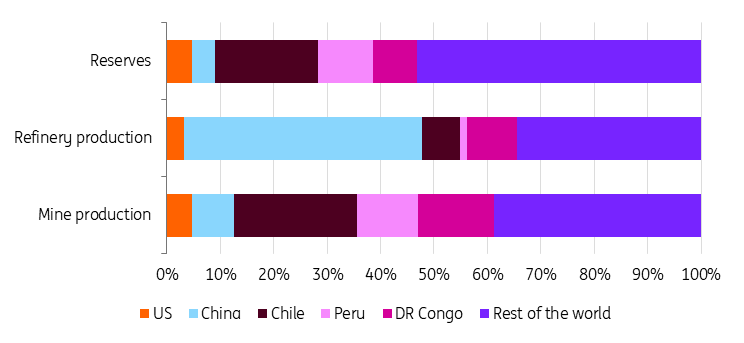Gevo shares jump as Q3 results top estimates, posts positive EBITDA
President Donald Trump last night announced a 50% tariff on copper imports, driving New York futures to a record high
US copper futures hit a record high yesterday – surging as much as 17% – after President Donald Trump announced he plans to implement a 50% tariff on copper imports. The magnitude of yesterday’s spike also set a record for a one-day increase.
Meanwhile, LME Prices Dropped More Than 4% Early This Morning.
Trump’s tariff on copper aims to boost domestic production of the metal and reduce the US’s reliance on imports. By imposing a 50% tariff on imported copper, the administration aims to encourage the development of new mining projects within the US and support the domestic copper industry.
However, the US produces only about 5% of the world’s copper and has seen a 20% decline in production over the last decade. Building new mines in the US can take up to 29 years due to lengthy permitting processes. We talk in more detail about this below.
What’s more, previous tariffs on steel and aluminium did not lead to increased domestic production of the two metals. In 2024, the output of the US steel industry was 1% lower than it had been in 2017 before the introduction of the first round of tariffs by Trump, while the aluminium industry produced almost 10% less.
Commerce Secretary Howard Lutnick said the copper tariffs are likely to be in place by the end of July. This would be the first time copper has faced import duties into the US. While the move doesn’t come as a surprise, the size of the levy does. The market had expected a tariff of up to 25%.
In February, Trump ordered a Section 232 investigation into copper imports and said, “It’s time for copper to come home.” However, the 270-day deadline for the investigation would have allowed it to continue until November.
The investigation encompassed raw mined copper, copper concentrates, copper alloys, scrap copper and derivative copper products. So far, there are no details on whether the tariffs will apply to all copper products.
The 50% tariff on copper follows duties already imposed on steel and aluminium. This would be the first time copper has faced tariffs in the US.
US Futures Trade at a Record Premium to Global Benchmark

Source: CME Group, LME, ING Research
US Copper at Record High
Copper in the US is up more than 40% so far this year, with prices continuing to benefit from the front-running of tariffs. The threat of tariffs has led to traders shifting metal from the global LME warehouses to the US to take advantage of the arbitrage. The US is reliant on copper imports for its domestic consumption. In 2024, the US imported around 850,000 tonnes of copper (excluding scrap), accounting for around 50% of its domestic consumption.
Chile is the largest import source, at around 40%, followed by Canada and Mexico. At least in the near term, it might be challenging to replace US copper imports with domestic production. These flows of imported metal are likely to continue.
US Copper Imports by Country (2024)

Source: TradeMap, ING Research
US Copper Imports by Type (2024)

Source: TradeMap, ING Research
Impact on the Market
This is likely to be positive for Comex copper prices, at least for now. More buying is likely before tariffs come into effect. However, the arbitrage has led to a buildup of inventories in US warehouses, which could temporarily buffer the market once the tariffs kick in.
A 50% tariff on imports also risks demand destruction, with copper prices in the US at a record high. This risks higher inflation, raising costs for US manufacturers without a domestic alternative available, at a time when President Trump has been pressuring the Federal Reserve to lower interest rates.
Yet this will be bearish for LME prices, with the wave of copper rushing to the US likely to stop once the tariffs are implemented. At that point, US buyers are likely to start working through their inventories. Copper holdings in Comex-registered warehouses more than doubled in the second quarter and now stand at the highest since 2018.
There is now more copper stored in Comex warehouses than in the LME and Shanghai Futures Exchange (SHFE) warehouses combined. This will likely improve the availability of copper, ex-US, with more copper showing up in LME warehouses, which would weigh on LME copper prices. This will likely only play out once tariffs are implemented. For now, the Comex-LME arb has widened to more than $2000/t, which will support the strong flow of copper into the US.
The key now will be which forms of copper will be affected and whether there will be exemptions for any suppliers.
The US Produces Around 5% of Global Copper Mining Output

Source: USGS, ING Research
US Import Reliance
The US produces around 5% of global copper mining output. Its reserves are also at around 5% of the total, according to the US Geological Survey (USGS). The country’s production has been on a downtrend, dropping about 20% over the last decade. Last year, US copper production fell 3% following an 11% drop in 2023.
Building a new mine takes, on average, 16 to 18 years – from the discovery stage of a deposit to the start of production. In the US, the process can be even longer, averaging nearly 29 years due to extensive permitting requirements, with the permitting process taking about seven to 10 years.
There is some idled capacity in the US, but the only two active primary copper smelters are Miami in Arizona, belonging to Freeport-McMoran (NYSE:FCX), and Kennecott in Utah, which belongs to Rio Tinto (NYSE:RIO).
A Better Alternative to Tariffs?
Export restrictions on scrap and ore, along with faster mine permitting, may better support US copper production than tariffs, as major US copper players have already suggested.
The Section 232 investigation notes that mitigation could include tariffs, export controls, or incentives. Tariffs are just one of several options.
Disclaimer: This publication has been prepared by ING solely for information purposes irrespective of a particular user’s means, financial situation or investment objectives. The information does not constitute investment recommendation, and nor is it investment, legal or tax advice or an offer or solicitation to purchase or sell any financial instrument. Read more
